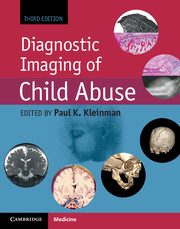Book contents
- Frontmatter
- Dedication
- Contents
- List of Contributors
- Editor’s note on the Foreword to the third edition
- Foreword to the third edition
- Foreword to the second edition
- Foreword to the first edition
- Preface
- Acknowledgments
- List of acronyms
- Introduction
- Section I Skeletal trauma
- Chapter 1 The skeleton: structure, growth and development, and basis of skeletal injury
- Chapter 2 Skeletal trauma: general considerations
- Chapter 3 Lower extremity trauma
- Chapter 4 Upper extremity trauma
- Chapter 5 Bony thoracic trauma
- Chapter 6 Dating fractures
- Chapter 7 Differential diagnosis I: diseases, dysplasias, and syndromes
- Chapter 8 Differential diagnosis II: disorders of calcium and phosphorus metabolism
- Chapter 9 Differential diagnosis III: osteogenesis imperfecta
- Chapter 10 Differential diagnosis IV: accidental trauma
- Chapter 11 Differential diagnosis V: obstetric trauma
- Chapter 12 Differential diagnosis VI: normal variants
- Chapter 13 Evidence-based radiology and child abuse
- Chapter 14 Skeletal imaging strategies
- Chapter 15 Postmortem skeletal imaging
- Section II Abusive head and spinal trauma
- Section III Visceral trauma and miscellaneous abuse and neglect
- Section IV Diagnostic imaging of abuse in societal context
- Section V Technical considerations and dosimetry
- Index
- References
Chapter 3 - Lower extremity trauma
from Section I - Skeletal trauma
Published online by Cambridge University Press: 05 September 2015
- Frontmatter
- Dedication
- Contents
- List of Contributors
- Editor’s note on the Foreword to the third edition
- Foreword to the third edition
- Foreword to the second edition
- Foreword to the first edition
- Preface
- Acknowledgments
- List of acronyms
- Introduction
- Section I Skeletal trauma
- Chapter 1 The skeleton: structure, growth and development, and basis of skeletal injury
- Chapter 2 Skeletal trauma: general considerations
- Chapter 3 Lower extremity trauma
- Chapter 4 Upper extremity trauma
- Chapter 5 Bony thoracic trauma
- Chapter 6 Dating fractures
- Chapter 7 Differential diagnosis I: diseases, dysplasias, and syndromes
- Chapter 8 Differential diagnosis II: disorders of calcium and phosphorus metabolism
- Chapter 9 Differential diagnosis III: osteogenesis imperfecta
- Chapter 10 Differential diagnosis IV: accidental trauma
- Chapter 11 Differential diagnosis V: obstetric trauma
- Chapter 12 Differential diagnosis VI: normal variants
- Chapter 13 Evidence-based radiology and child abuse
- Chapter 14 Skeletal imaging strategies
- Chapter 15 Postmortem skeletal imaging
- Section II Abusive head and spinal trauma
- Section III Visceral trauma and miscellaneous abuse and neglect
- Section IV Diagnostic imaging of abuse in societal context
- Section V Technical considerations and dosimetry
- Index
- References
Summary
The femur
The femur is the most common traumatic site of orthopedic injury requiring hospitalization and it is also the most common site of extremity injury in abused children (1–5). It has received more attention in the child abuse literature than any other long bone. Differentiation between an inflicted and an accidental femoral fracture commonly poses a daunting clinical and imaging challenge, and a thorough familiarity with the various aspects of this subject is necessary to view the role of diagnostic imaging in the appropriate clinical context.
Between 1946 and 1952, Caffey and others described the association of femoral fractures with subdural hematomas (SDHs) in infants (6–8). Femoral fractures in infants were described in several other reports in the 1950s, and many of those accounts pointed to abuse as a possible cause of injury (9–15). The first chapter on these injuries came to a close with Kempe and colleagues’ grouping of these and other radiologic and clinical manifestations of child maltreatment under the concept of the “Battered Child Syndrome.”(16).
An early review of fractures cited in five large series of abused children revealed an overall prevalence of femoral fractures of 20% (17–22). Femoral fractures in infants have a strong association with abuse, whereas similar fractures in older children are usually determined to be accident (23–31). Beals and Tufts analyzed 80 femoral fractures in children under 4 years of age and found that 8.5% of the fractures were caused by violent (accidental) trauma, 12.5% were pathologic in nature, and 30% were caused by child abuse (24). The remaining fractures were the result of lesser accidental trauma to otherwise normal children. Femoral fractures secondary to abuse were found to be more common in children less than one year of age who were firstborns and had preexisting brain damage. The fractures, which were often bilateral, occurred with two peak age incidences: six months and three years.
- Type
- Chapter
- Information
- Diagnostic Imaging of Child Abuse , pp. 53 - 120Publisher: Cambridge University PressPrint publication year: 2015



